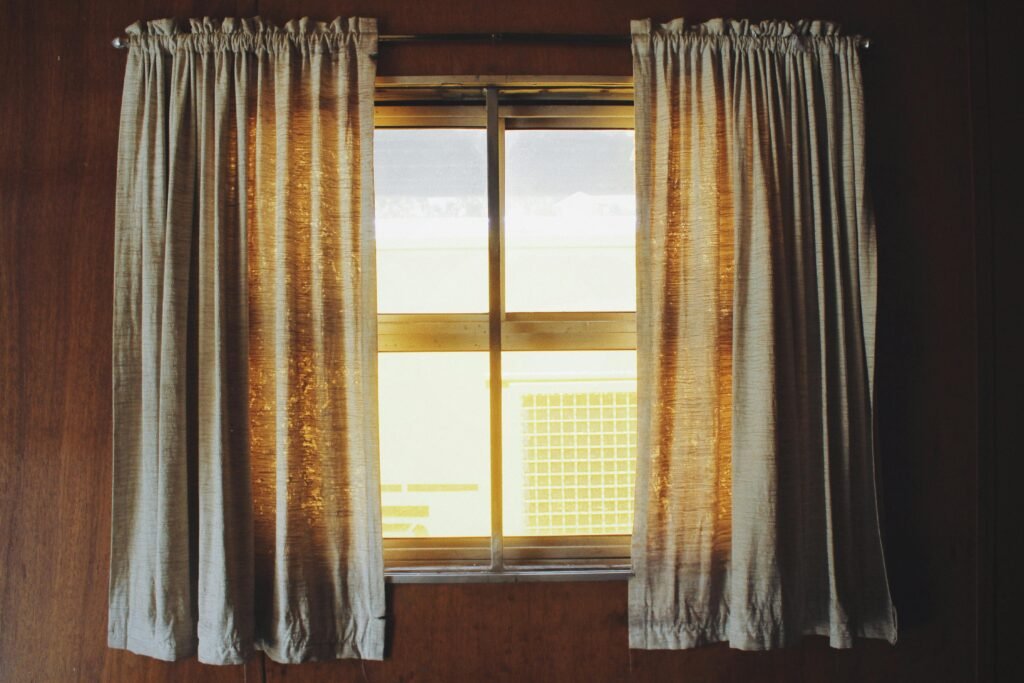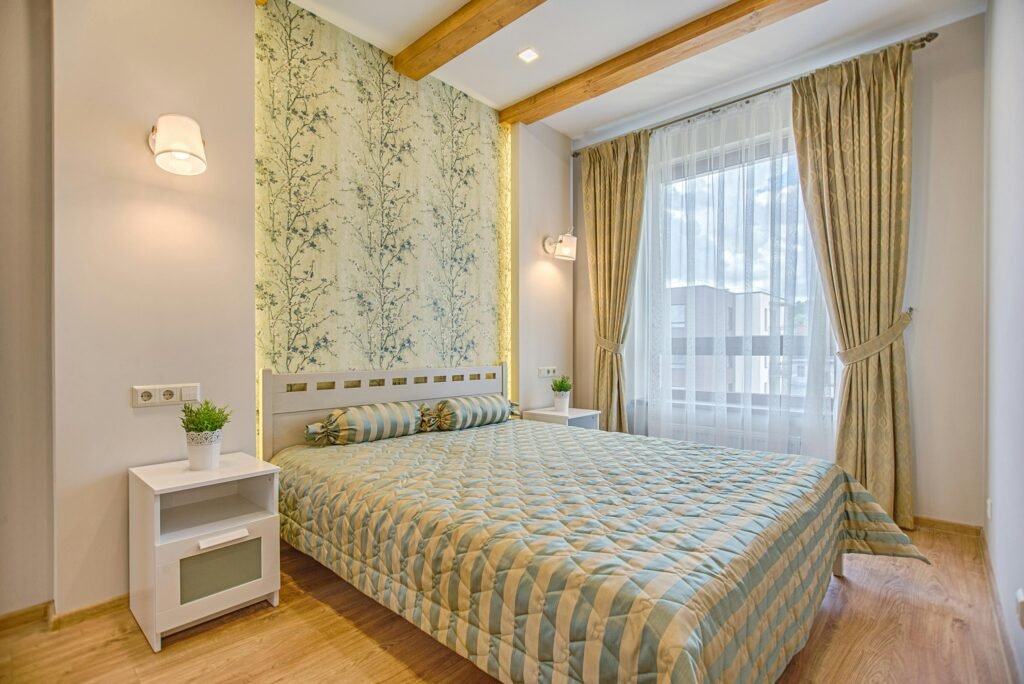Not sure which curtains will best complement your decor style?

How Can I Choose Curtains That Match My Decor Style?
Choosing curtains that match your decor style involves more than picking a pretty fabric. You’ll want to consider function, scale, color, texture, hardware, and how the curtains interact with your existing furniture and lighting to create a cohesive look.
Start by Identifying Your Decor Style
Before you shop, identify the dominant style in your room. Knowing your decor style makes it much easier to narrow fabric choices, colors, and hardware that will feel intentional rather than accidental. If your room blends styles, think about which influence you want the curtains to emphasize.
Common decor styles and what defines them
Each decor style has signature elements—clean lines, ornate details, natural textures, or bold color palettes. Recognizing those elements will help you choose curtain shapes, fabrics, and colors that support the room’s overall mood.
How your lifestyle affects the style you choose
Your daily lifestyle should influence your curtain choice. If you have pets or kids, durable fabrics and easy-care options will be more practical. If you use a room for formal entertaining, you might favor heavier, more structured curtains.
Determine the Function of the Curtains
Curtains can be decorative, functional, or both. Decide whether you want them primarily for privacy, light control, insulation, or purely aesthetic framing of the window.
Light control and privacy needs
Think about how much natural light you want and when you want privacy. Rooms facing public streets or neighboring windows may need more opaque or layered solutions. Bedrooms often need blackout options for better sleep.
Insulation and energy efficiency
If you want to reduce drafts and energy bills, thermally lined or heavier fabrics will help. Consider curtain length and fullness as part of a strategy to trap warm air in winter and block heat in summer.
Measure Your Windows Accurately
Proper measurements prevent curtains that are too short, too narrow, or awkwardly placed. Accurate measuring helps ensure proportion and a polished finish.
Width: how wide to make your curtains
Measure the full width of the window and add extra for fullness. A general guideline is 1.5 to 3 times the width of the window for pleated or gathered looks. For a flat panel look, 1.5 times may be enough; for lush, layered drapes, aim for 2.5 to 3 times the width.
Length: where the curtains should hit
Decide whether you want the curtains to:
- Hang to the window sill (good for radiators or short windows),
- Break slightly on the floor (a few centimeters of break),
- Pool on the floor for a romantic, formal look (longer than the floor length). Measure from the rod or track to the desired hemline, and measure each window in case there are variations.
Choose the Right Fabric
Fabric choice affects drape, opacity, maintenance, and how well the curtain fits your style. Different fabrics signal different moods.
Common curtain fabrics and their characteristics
Use fabrics to convey texture and formality. Lightweight linen or cotton creates casual, airy looks. Velvet or heavy brocades offer glamour and warmth. Sheer fabrics provide soft filtering and an ethereal feel.
Table: Fabric types, look, pros, cons
| Fabric | Look & Feel | Pros | Cons |
|---|---|---|---|
| Linen | Natural, relaxed, slightly textured | Breathable, light-filled, casual | Wrinkles easily, less insulating |
| Cotton | Versatile, available in many weaves | Easy to wash, budget-friendly | Can fade in sun, varies by weave |
| Velvet | Luxurious, formal, plush | Excellent for insulation and blackout | Heavier, may require professional cleaning |
| Silk (or faux silk) | Elegant, luminous sheen | Drapes beautifully, formal | Expensive, delicate |
| Polyester/Microfiber | Practical, affordable | Durable, fade-resistant, easy care | Can look synthetic if low quality |
| Sheer voile | Airy, translucent | Softens light, light-weight | Offers little privacy or insulation |
| Thermal-lining blends | Functional, insulated | Energy-efficient, reduces noise | Adds weight, may need special care |
How fabric weight influences your decor style
Lightweight, sheer fabrics suit minimalist, coastal, or Scandinavian aesthetics. Medium-weight cottons and linens are great for casual, rustic, and transitional rooms. Heavy fabrics like velvet suit traditional or formal spaces.
Pick Colors and Patterns That Complement Your Palette
Curtains can reinforce or contrast your color scheme. Decide whether you want them to blend in, act as a neutral frame, or become a focal point.
Matching versus contrasting colors
Matching colors creates cohesion and can make your room feel bigger by avoiding visual interruption. Choosing contrasting colors adds drama and can emphasize windows as focal points. Use color theory: complementary colors create pop, analogous colors create harmony.
Pattern scale and how it interacts with the room
Large patterns suit big rooms or windows and can be overwhelming in small spaces. Smaller patterns read as texture from a distance and work well in compact rooms. If your furniture already has bold patterns, opt for simpler curtain patterns or solids.
Table: Pattern scale guidelines
| Room size | Pattern suggestion | Why |
|---|---|---|
| Small room | Solids or small-scale patterns | Prevents visual clutter |
| Medium room | Medium-scale patterns or subtle textures | Adds interest without overpowering |
| Large room | Large-scale patterns or bold prints | Creates impact and anchors space |

Match Curtain Style to Specific Decor Themes
Use curtain cues to strengthen your preferred design aesthetic. Below are suggestions for common decor styles.
Modern and Contemporary
Choose clean lines, minimal patterns, and neutral or bold solid colors. Motorized or sleek grommet and tab-top headers often complement this look. Opt for single layers or subtle sheers rather than heavy pleats.
Traditional and Classic
Rich fabrics, structured pleats, and tailored valances work well. Look for damask, velvet, and brocade in deep or muted tones. Swags, cascades, and layered treatments suit formal spaces.
Scandinavian
Prioritize light, airy fabrics in neutral palettes and natural textures. Linen and cotton in whites, greys, and soft pastels are ideal. Keep hardware minimal and unobtrusive.
Bohemian and Eclectic
You can mix colors, textures, and patterns freely. Consider embroidered textiles, tapestries, or layered sheers with patterned panels. Tassels and eclectic rods enhance the boho vibe.
Farmhouse and Cottage
Use lighter linens, ticking stripes, gingham, or subtle floral prints. Simple rod-pocket or tab-top headers and rustic wooden rods complement the cozy aesthetic.
Industrial
Choose heavier fabrics in neutral or darker shades, possibly with metallic or leather hardware. Simple, unlined panels or blackout curtains with minimal detailing work best.
Coastal
Lightweight sheers, linen blends, and sandy neutrals with blue accents fit coastal themes. Keep it breezy and sunlit; consider semi-sheer layers to mimic seaside light.
Mid-century Modern
Go for geometric patterns, bold color accents, and fabrics with clean drape. Grommet or minimalist rod hardware in matte finishes pair nicely.
Select the Right Curtain Header and Hardware
Header style affects how curtains hang and how formal they read. Hardware also contributes heavily to the overall look.
Header styles and the visual effect
Common headers include rod pocket, grommet, pinch pleat, pencil pleat, and tab top. Rod pockets and tab tops read casual; pinch pleats and tailored pleats read formal. Grommets read modern and clean.
Table: Header styles, best for, look
| Header | Best for | Visual effect |
|---|---|---|
| Rod pocket | Casual rooms | Soft, relaxed gathers |
| Grommet | Modern/minimal | Smooth, even folds |
| Pinch pleat | Traditional/formal | Structured, tailored look |
| Pencil pleat | Versatile | Classic gathered look |
| Tab top | Informal/boho | Playful, simple drape |
Choosing rods, finials, and brackets
Select rod finishes and finial styles that coordinate with furniture and other metal finishes in the room. For example, matte black or brushed nickel suits modern rooms; antique brass pairs with traditional; natural wood rods match rustic or Scandinavian aesthetics.
Decide on Lining and Layering
Lining alters opacity, durability, and insulation. Layering lets you combine privacy with light control and adds dimension.
Types of linings and benefits
Unlined: Airy and light, but offers poor insulation.
Standard lining: Protects fabric from UV, increases opacity.
Thermal or blackout lining: Blocks light, improves insulation and privacy.
Layering options
Use a sheer layer for daytime light diffusion and a heavier drape for privacy or blackout. You can mount a double rod or use tracks to create layered looks that are both functional and stylish.

Consider Maintenance and Durability
Curtains are a long-term investment; choose fabrics and finishes that fit your willingness to maintain them.
Cleaning methods and care labels
Check whether panels are machine washable, dry-clean only, or spot-clean recommended. Fabrics like polyester and treated cottons are often easier to clean. Velvet and silk usually need professional care.
Durability and sun resistance
If curtains will receive significant sun exposure, choose fade-resistant fabrics or linings. UV exposure can significantly shorten the lifespan of delicate textiles.
Budget: Ready-Made vs Custom Curtains
Your budget affects whether you choose off-the-shelf panels or custom-made curtains.
Pros and cons of ready-made
Ready-made curtains are more affordable and immediate. They come in standard sizes, so they’re best if your windows are typical dimensions. However, they may lack the perfect length, fullness, or fabric choice.
Pros and cons of custom-made
Custom curtains let you specify exact dimensions, fabric, linings, and details. They cost more and take time, but they pay off if you have unusual windows, want premium fabric, or require precise tailoring.
Practical Tips for Measuring, Buying, and Installing
Small mistakes in measurement or installation can ruin the final look. Follow practical rules to get professional results.
Measuring checklist
- Measure the window width and add desired fullness.
- Measure from where the rod will sit (typically 4–6 inches above the frame for a taller appearance).
- Measure each window individually if installing more than one, because windows often vary slightly.
- Account for obstructions like radiators, molding, or baseboards.
Installation tips
Mount rods higher and wider than the window to create the illusion of more space. Use sturdy brackets for heavy curtains and ensure tracks are level to prevent uneven hanging.
Styling Curtains by Room
Different rooms have different functional needs and aesthetic goals. Tailor your curtain choices accordingly.
Living room
You’ll likely want a balance of light and privacy. Layered sheers with heavier side panels work well. Consider showier fabrics or patterns here since living rooms are shared and more public.
Bedroom
Prioritize blackout and insulation for sleep comfort. Thick fabrics, thermal linings, or blackout liners are useful. Consider full-length panels that touch or pool on the floor for a luxurious feel.
Kitchen
Kitchens benefit from easy-care fabrics and shorter lengths to keep them out of the way of spills. Cafe curtains, roller shades, or washable cotton panels are practical.
Bathroom
Use moisture-resistant fabrics or installed blinds/shades designed for high humidity. If you want fabric, ensure it’s washable and hangs short or is kept away from splashes.
Home office
Choose options that reduce glare while keeping some light. Medium-weight fabrics or layered sheers and heavier panels give you versatility for both daytime focus and evening privacy.
Mix and Match: Pattern and Texture Rules
You can successfully mix patterns and textures if you follow a few rules about scale, color, and repetition.
Basic pattern mixing strategy
Choose one dominant pattern and pair it with one or two supporting patterns of different scales. Make sure there’s a color thread that ties the patterns together to keep the look cohesive.
Using texture as a neutral
If you’re nervous about bold patterns, use textured solids—slubby linen, nubby weaves, or brushed velvet—to introduce interest without overwhelming the room.
Try Samples and Test in Your Space
Buying samples can prevent costly mistakes. Fabric appearance changes with light, so test swatches in the room at different times of day.
How to test swatches effectively
Pin or tape fabric samples next to the window and observe how they look in morning, midday, and evening light. Test lining options and hold the sample up to other textiles in your room to check color harmony.
Sustainable and Eco-Friendly Options
If sustainability matters to you, there are eco-friendly fabrics and production methods to consider.
Materials and certifications to look for
Look for organic cotton, hemp, linen, or recycled polyester. Certifications like GOTS (Global Organic Textile Standard) and OEKO-TEX indicate responsible production and safer dyes.
Longevity and reducing waste
Choose durable fabrics you’ll keep for years and consider buying timeless styles rather than fast-fashion trends. When replacing curtains, donate or repurpose old panels to reduce waste.
Final Styling and Maintenance Checklist
Before finalizing your curtain choice, run through a checklist to ensure everything aligns with your needs and style.
- Have you measured accurately and allowed for fullness?
- Does the curtain fabric meet your light control and privacy needs?
- Is the color/pattern coordinated with your room palette and scale?
- Are the curtain hardware and header consistent with your decor style?
- Does the fabric meet maintenance expectations (washability, sun resistance)?
- Have you tested samples in the room under real light conditions?
- Do you prefer ready-made for budget or custom for perfect fit?
Frequently Asked Questions
How high above the window should I install the curtain rod?
Install rods 4–6 inches above the window frame for a standard look, or go up to the ceiling or crown molding to make the room feel taller. The higher you go, the more dramatic and elongated the window will appear.
How full should curtains be?
For a gathered look, aim for 1.5–3 times the width of the window. 2–2.5 times is a common sweet spot for a rich yet not overly heavy appearance.
Can I use the same curtains throughout the whole house?
You can, but it might make the house feel monotonous. Consider repeating a color or texture as a common thread, while varying patterns and weights by room to suit function and mood.
Quick Reference Tables
Table: Curtain lengths and visual effect
| Length | Typical use | Visual effect |
|---|---|---|
| Below sill (to sill) | Kitchens, radiators | Practical, neat |
| To floor (no break) | Modern, clean look | Elegant, tailored |
| Slight break (1–2 cm) | Most living spaces | Classic, polished |
| Puddled/pooling | Formal or romantic spaces | Luxurious, dramatic |
Table: Decor style vs curtain suggestions
| Decor style | Fabric suggestions | Header & hardware |
|---|---|---|
| Modern | Solid, linen blends, polyester | Grommet or hidden pocket, sleek rods |
| Traditional | Velvet, silk, brocade | Pinch pleat, ornate finials |
| Scandinavian | Light linen/cotton, neutrals | Minimal rods, simple gathers |
| Boho | Embroidered cotton, mixed textiles | Wooden rods, eclectic tiebacks |
| Farmhouse | Linen, cotton checks | Rod pocket or cafe rods, wooden rods |
| Industrial | Heavy canvas, dark solids | Exposed metal rods, matte finishes |
Conclusion
Choosing curtains that match your decor is a mix of practical choices and aesthetic decisions. By considering function, measuring carefully, selecting appropriate fabrics, and coordinating color and hardware with your existing decor, you’ll achieve a result that elevates the room and feels intentionally curated. If you’re uncertain, order fabric samples, experiment with layering, and don’t hesitate to consult a professional for custom options that fit your space perfectly.
